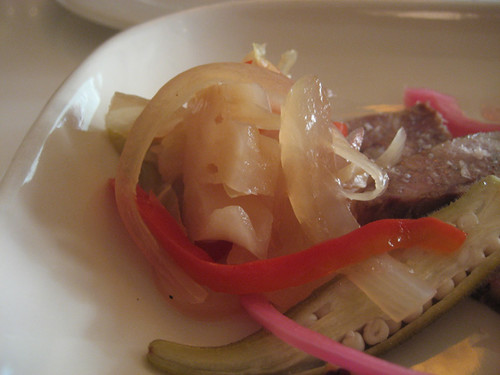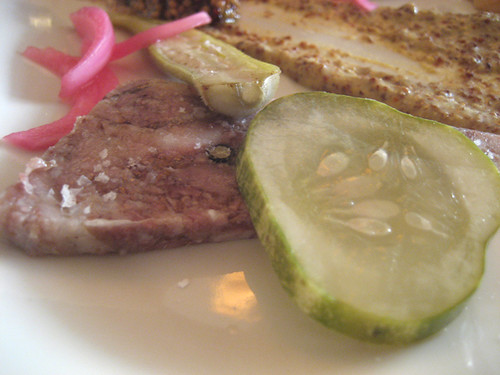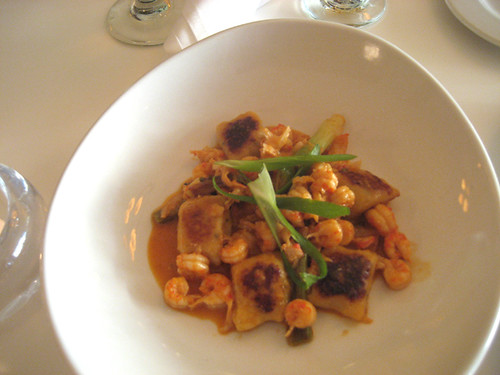
I liked the idea of Big Jones a little more than the reality of it, the first time I went. That was almost two years ago and the restaurant was fairly new; it was a good enough meal for the price that I offered some qualified hope for the future:
The menu is still somewhat short and limited to pretty familiar things— gumbo, pulled pork, steak (!)— but maybe, over time, it will dig deeper into Southern traditions and become a Chicago equivalent of some of the innovative new Southern restaurants.
Actually, I feel like I do that too much— write that a place might turn into some other place, eventually. You should review the restaurant in front of you and not what it might become; generally speaking, restaurants get worse, not better. But there is some chance, at least, that one will get into a groove and sharpen their vision and, hey, just get better at competence. It happens.
I paid some attention to the ups and downs of Big Jones on LTHForum, but what really interested me in going again was reading chef Paul Fehribach’s blog, because he was doing exactly what I’ve been doing off and on for the last few years. Like me, he grew up in a midwestern state with just tinges of southern food around the edges, but it was enough to create a love for it as a deeper, richer heritage to explore than one’s own regional cuisine (and Midwest, I love ya, but we both know there’s just a lot more going on in the South). Like me, he’s dug into old cookbooks and adapted local produce to Southern recipes. Okay, he’s probably done about 1000 times more of it than I have, but the point is, I liked where he was coming from. Another chef whose blog was tasty enough to make me want to see if the food was, too.
And in short: yes, it pretty much is. I’m not sure how much more Southern it is than it was before. Sometimes it was, like the really tasty sweet-sour chow-chow in the picture at the top, which went with this head cheese:

Apart from the pickled okra and whatnot around it, though, the head cheese could have come from Mado or Old Town Social or The Purple Pig; there was nothing specifically Southern about it. But at the same time, hey, it could have come from Mado or Old Town Social or The Purple Pig; it tasted of superior meat and delicately exact seasoning, and with the combination of dijon mustard and sweet-vinegary chow chow, it was pretty terrific and a credit to any chef’s charcuterie skills.
So that’s kind of what I think about Big Jones now: the Southern thing varies from dish to dish, but the level of execution is plainly much higher than two years ago, taking very high quality, frequently local ingredients and doing as right by them as anybody in the same price range. I don’t think crawfish gnocchi is terribly common on the bayou, and jerk-seasoned skirt steak with chimmichurri sounded a lot like the kind of dishes you find in upscale Mexican restaurants, where Mexican flavors are forced into the a-steak-and-a-side format of American dining— but both were very tasty, the steak cooked perfectly and the heat and chimmichurri giving it a touch of the exotic, the gnocchi light and fluffy and serving as a great textural base for the slightly fishy red pepper sauce:

And when we did get something that was pretty much classic Southern, it was very well done. As C.J.’s Eatery has evidently closed, I will be in mourning and wearing black this weekend for their shrimp and grits, but it’s at least some consolation to know that Big Jones has a very good upscale version, creamy grits set off by a salty Tasso ham gravy, the grits actually made in-house. I don’t mean cooked in-house, I mean:
traditional grits are produced by soaking dried corn kernels in a solution of baking soda, lime, or wood ash (“lye water”) for a day or two. The kernel’s shell pops off, and the kernel swells to twice its size. Kernels are rinsed more than once, then dried, and finally ground into grits.
Yow, that’s some dedication, compared to simply calling Anson Mills to place an order. I was less excited by tea-brined pork, which was pleasantly cooked pork, but didn’t get anything from the tea that I particularly tasted; and I wasn’t wild about dessert. We had a couple of some kind of doughnut made with rice flour, which was pretty good, but it came accompanied by frozen cherries, which I think was supposed to make them refreshing but made them sort of like chewing erasers. And a cherry pie with benne (sesame seed) ice cream had good flavor, but not much delicacy. (It was also a freebie from the chef, I should point out.) This is a region that likes its sweets, I know there’s more interesting and better things out there. Still, when we tallied up the meal, the several standouts easily outweighed the few others.
At the end of the meal Fehribach came out to talk to us and confirmed much of what I came to feel over the course of it— that he has worked steadily to improve the restaurant since its opening, buying better ingredients, working on more authentic recipes, getting better at his job. One thing he said— it could have been flattery, but I’m gonna take it and run with it— is that he was inspired to try to use only sustainable seafood after attending the Supreme Lobster event at the Shedd and seeing my video about sustainable seafood.
Sure enough, those were Laughing Bird shrimp in the grits, talked about in the video. Frankly, there’s something a little bland about them, but this is what you want to use them for, something that has plenty of other flavor that would overwhelm delicate shrimp flavor anyway. If you’re paying that much attention to the shrimp, there’s not enough cream or cheese in your grits. That was not a problem Big Jones’ grits had.


 If you like this post and would like to receive updates from this blog, please subscribe our feed.
If you like this post and would like to receive updates from this blog, please subscribe our feed.




